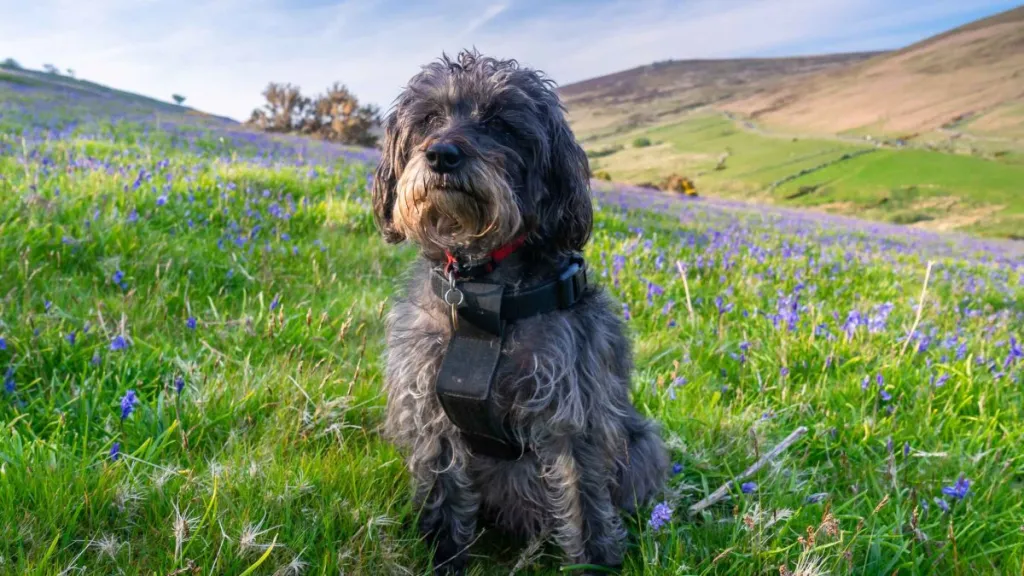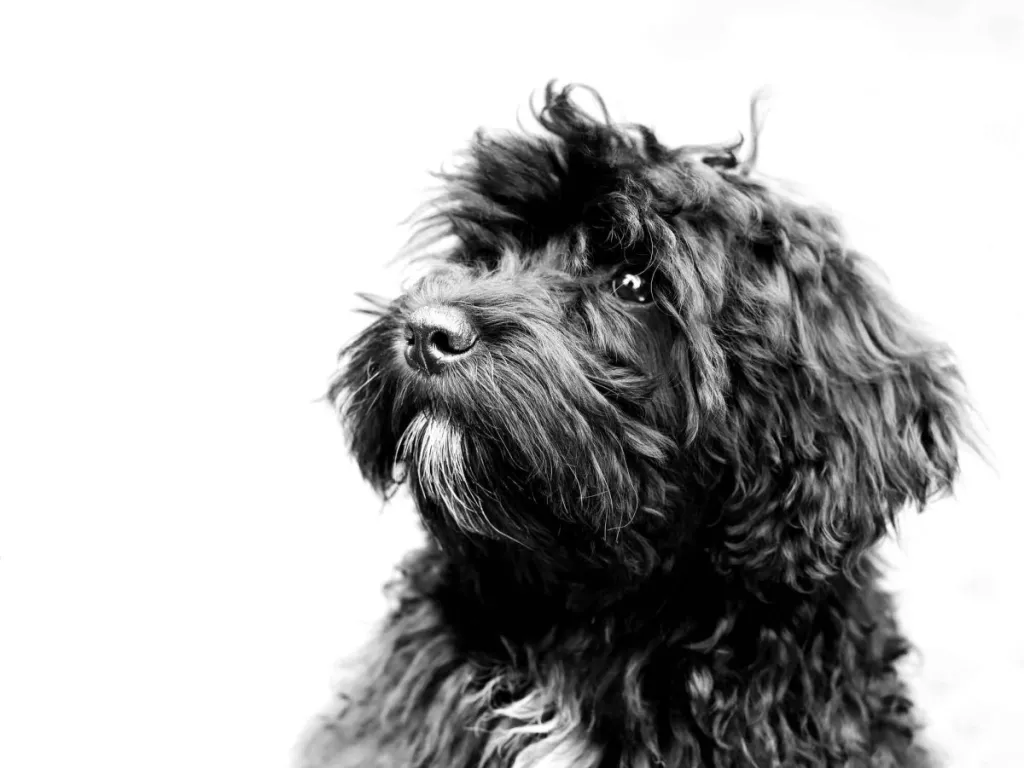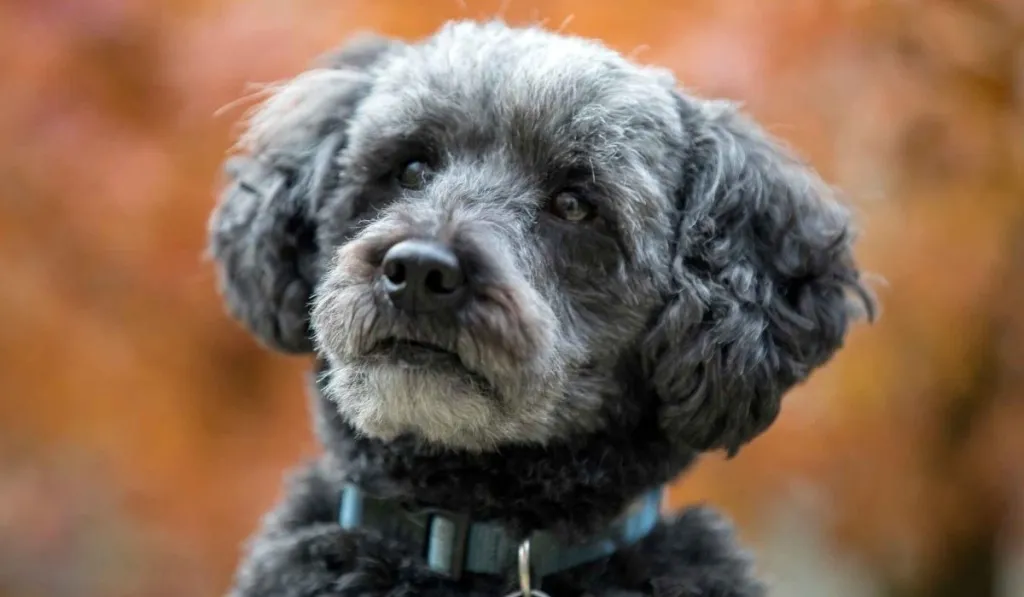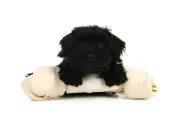The Schnoodle is a kid-friendly designer dog breed created by crossing a Schnauzer with a Poodle, combining the best traits of both parent breeds. This hybrid is celebrated for their intelligence, affectionate nature, and lively personality. Schnoodles come in a range of sizes—Toy, Miniature, Standard, and Giant—depending on the size of their Schnauzer and Poodle parents. Their coats are low-shedding and can showcase various colors, including black, gray, white, sable, and apricot, making them a great choice for allergy-conscious families. Active but not overly hyper, Schnoodles are loyal companions who thrive on social interaction and love spending time with their families. They are unsuitable for long periods of isolation and form strong bonds with their owners, sometimes favoring one person in the household.
The size and growth of a Schnoodle can vary significantly, with smaller varieties like Toy and Miniatures typically reaching full maturity earlier than larger ones. Most Schnoodles reach their adult size between 12 and 18 months. These dogs are adaptable and versatile, making them well-suited for various lifestyles, whether in apartments or homes with yards.
Schnoodle characteristics
- Weight: Schnoodles come in four sizes: Toy, Miniature, Standard, and Giant. A Toy Schnoodle weighs 5-15 pounds, a Miniature Schnoodle weighs 15-30 pounds, a Standard Schnoodle weighs 30-50 pounds, and a Giant Schnoodle weighs around 50-70 pounds.
- Height: 10 to 26 inches tall at the shoulder
- Lifespan: 12-15 years
Schnoodle sizes
Toy Schnoodle
- Parent Breeds: Toy Poodle and Miniature Schnauzer.
- Height: 10–12 inches at the shoulder.
- Weight: 6–12 pounds.
Miniature Schnoodle
- Parent Breeds: Miniature Schnauzer and Miniature or Toy Poodle.
- Height: 12–16 inches at the shoulder.
- Weight: 13–20 pounds.
Standard Schnoodle
- Parent Breeds: Standard Schnauzer and Standard Poodle.
- Height: 16–20 inches at the shoulder.
- Weight: 20–45 pounds.
Giant Schnoodle
- Parent Breeds: Giant Schnauzer and Standard Poodle.
- Height: 20–26 inches at the shoulder.
- Weight: 50–70 pounds.
Coat and color variations
Schnoodles have versatile and attractive coats, often combining traits from both Schnauzers and Poodles. Their fur can range from wavy to curly, with some having a softer, more Poodle-like texture and others inheriting the wiry coat of the Schnauzer. These low-shedding coats make Schnoodles a popular choice for individuals with allergies, though grooming needs can vary depending on the coat type. Regular brushing and occasional trims help maintain their coat’s health and appearance, keeping it free from tangles and mats.
In terms of color, Schnoodle coats come in a wide array of colors. Common coat colors include black, gray, white, and sable, but apricot, cream, and bi-color variations are also seen. Some Schnoodles may even inherit unique patterns like parti-color or phantom markings.

Physical features and appearance
Size and build
- Size: Ranges from Toy to Giant, depending on parent breeds.
- Weight: Typically 10–70 pounds, varying by size category.
- Build: Compact and athletic, with a balanced and proportionate body.
Coat colors and texture
- Coat: Wavy to curly, low-shedding, and hypoallergenic.
- Colors: Black, gray, white, sable, apricot, cream, and more, with possible bi-color or patterned markings.
Facial features
- Eyes: Expressive and almond-shaped, often dark brown.
- Ears: Floppy and medium-sized, adding to their friendly appearance.
- Head: Medium-sized, well-proportioned to the body, with a slightly rounded skull.
- Muzzle: Straight and moderately long, blending Schnauzer sharpness with Poodle refinement.
Are Schnoodle dogs hypoallergenic?
Yes, Schnoodles are often considered hypoallergenic, but it’s important to note that no dog is completely free of allergens. Schnoodles tend to shed very little due to their Poodle heritage, which makes them a better choice for people with allergies. The low-shedding coat reduces the spread of dander, a common allergen, in the home.
Furthermore, the degree of hypoallergenic traits depends on whether the Schnoodle inherits more of the Poodle’s curly coat or the Schnauzer’s wiry coat. Curly coats tend to trap dander more effectively, reducing allergens in the environment.
Schnoodle history
The Schnoodle was developed in the 1980s when the interest began to grow in Poodle crosses. The original goal with the Schnoodle was to create a low-shedding, low-dander family dog. Although the Schnoodle hasn’t quite gained the popularity of other “designer” breeds, there’s a strong following that has created a demand for Schnoodle puppies.
The Schnoodle is generally the result of breeding between a Schnauzer and a Poodle, although some breeders have started breeding multigenerational Schnoodles (Schnoodles bred to other Schnoodles). Right now there are no breed clubs or standards, but efforts have begun to create both.
Schnoodles can come in a variety of sizes since there are three Poodle sizes and three Schnauzer sizes. The range of possibilities has created an interesting variety of hybrids. Despite that, Schnoodles have traditionally been small dogs. The introduction of the Giant Schnauzer and Standard Poodle into the mix is the most recent variation, producing a dog of a different temperament from the small, cuddly Schnoodle.
Schnoodle temperament
The Schnoodle, a crossbreed between a Schnauzer and a Poodle, is known for their lively, affectionate, and intelligent personality. These dogs are highly adaptable, making them excellent companions for various living situations, from apartments to larger homes. Schnoodles are people-oriented and thrive on human interaction, forming strong bonds with their families. They often inherit the Poodle’s eagerness to please and the Schnauzer’s alertness, making them both playful and protective. This blend of traits makes them a great choice for families, singles, and seniors alike.
Schnoodles are typically energetic and love to engage in activities like walks, playtime, or learning new tricks. While they are generally good with children and other pets, early socialization is crucial to ensure a well-rounded temperament. Their intelligence can sometimes lead to stubbornness, but consistent training and positive reinforcement help mitigate this. Schnoodles are also known for being relatively quiet, though they can be vocal if they sense something unusual, reflecting their Schnauzer heritage as watchdogs.

Behavior and personality traits
- Affectionate: Loves spending time with family and thrives on attention.
- Intelligent: Quick learners, but can occasionally be stubborn.
- Energetic: Enjoys playtime, walks, and other activities.
- Adaptable: Suitable for apartments or larger homes.
- Protective: Alert and may act as a watchdog.
- Sociable: Gets along well with children and other pets with proper socialization.
- Quiet: Generally not overly vocal but may bark at unfamiliar sights or sounds.
- Eager to Please: Responds well to training with positive reinforcement.
Training and socialization
Schnoodles are intelligent and eager to please, making them relatively easy to train. Early training is essential to establish good habits and curb any potential stubbornness inherited from their Schnauzer lineage. Positive reinforcement techniques, such as treats, praise, and play, work best to keep them engaged and motivated. Socialization should begin early to expose them to different environments, people, and other animals, helping them grow into well-rounded and confident dogs. Regular mental stimulation, such as puzzle toys or advanced training exercises, is crucial to prevent boredom and unwanted behaviors.
Pros and cons of a Schnoodle
Schnoodles offer many benefits, making them a popular choice for dog lovers. Their hypoallergenic, low-shedding coat is ideal for allergy sufferers, while their affectionate and loyal nature ensures they form strong bonds with their families. Highly intelligent and eager to please, they are quick learners and relatively easy to train. Schnoodles are adaptable to various living environments, thriving in both apartments and larger homes, and their energetic demeanor makes them a great match for active individuals or families. Additionally, they are typically good with children and other pets when socialized early, and their generally quiet nature makes them a low-noise companion, though they remain alert and protective when necessary.
Despite their many positives, Schnoodles have some drawbacks. They require regular grooming to maintain their coat and reduce allergens, which can be time-consuming and costly. Their strong attachment to their families can lead to separation anxiety if left alone for extended periods, and their high energy levels demand consistent physical and mental stimulation to prevent boredom and destructive behaviors. Schnoodles may also inherit a stubborn streak from their Schnauzer lineage, making consistent training essential. As a designer breed, they can be expensive to purchase and maintain.
Schnoodle care
Caring for a Schnoodle involves meeting their physical, emotional, and grooming needs to ensure they remain healthy and happy. Regular exercise is essential, as they are energetic dogs who enjoy daily walks, playtime, and mental stimulation through training or puzzle toys. Schnoodles benefit from early socialization to develop well-rounded personalities, and ongoing training helps curb any stubbornness. Grooming is a key part of their care routine, especially if they inherit the Poodle’s curly coat, which requires regular brushing and occasional professional grooming to prevent matting. Additionally, keeping up with routine veterinary care, including vaccinations, flea/tick prevention, and dental hygiene, is important for their overall health.
How to groom a Schnoodle
Brushing and bathing
- Brush Regularly: Brush your Schnoodle’s coat 2-3 times a week to prevent matting and tangling. Use a slicker brush for their curly or wavy coat to keep it smooth.
- Bathing: Bathe your Schnoodle every 4-6 weeks, or as needed. Use a mild dog shampoo to keep their coat clean and healthy. Make sure to rinse thoroughly to avoid skin irritation.
- Trim Their Coat: Schnoodles require regular haircuts, especially around the face, paws, and ears. You can take them to a professional groomer or trim them at home using clippers. Be careful around sensitive areas.
Ears, nails, and teeth
- Clean Their Ears: Schnoodles, especially those with floppy ears, are prone to ear infections. Clean their ears weekly with a vet-approved ear cleaner to prevent buildup.
- Nail Trimming: Trim their nails every 3-4 weeks to prevent overgrowth and discomfort. Use dog nail clippers and be cautious not to cut too close to the quick.
- Teeth Brushing: Brush their teeth 2-3 times a week with a dog-specific toothbrush and toothpaste to maintain good oral health and prevent dental issues.
Early acclimation is key
Early acclimation to grooming is essential for a Schnoodle to ensure they remain comfortable and relaxed during their grooming routine. Start by introducing grooming tools, like brushes and clippers, gradually and associating them with positive experiences such as treats and praise. Begin with short grooming sessions, focusing on brushing and gentle handling, to help your Schnoodle get used to the process. Consistency is key — by making grooming a regular, stress-free activity from a young age, your dog will learn to accept it as part of their routine and be more cooperative as they grow.
Feeding and nutrition
Recommended daily amount: 3/4 to 1 cup of high-quality dry food a day for the most common size of Schnoodle, weighing from 15 to 20 pounds. You’ll need to feed yours less if he’s smaller, and significantly more if a Giant Schnauzer is one of the parents. Keep your Schnoodle in good shape by measuring his food and feeding him twice or three times a day rather than free feeding, or leaving food out all the time.
Check with your veterinarian if you’re unsure about the feeding needs of your particular dog. How much your adult dog eats depends on his size, age, build, metabolism, and activity level. Dogs are individuals, just like people, and they don’t all need the same amount of food. A highly active dog will need more than a couch potato dog.
Small Schnoodles (Under 15 lbs)
- Calories: Approximately 300-400 calories per day.
- Food: A high-quality, small-breed dog food that is rich in protein and low in fillers is ideal. Look for food with real meat as the first ingredient and a balance of healthy fats and fiber for energy.
- Portion Size: Typically, small Schnoodles need about 1/2 to 1 cup of food per day, split into two meals.
Medium Schnoodles (15-25 lbs)
- Calories: Around 400-600 calories per day.
- Food: Choose a medium-breed dog food that supports their energy levels and provides a good balance of protein, fat, and carbohydrates. Look for options with high-quality ingredients and nutrients for joint and coat health.
- Portion Size: Typically, they will require 1 to 1.5 cups of food daily, divided into two meals.
Large Schnoodles (Over 25 lbs)
- Calories: Approximately 600-800 calories per day.
- Food: Large Schnoodles benefit from a high-protein, nutrient-dense food to support their muscle mass and energy needs. A larger breed formula is best to ensure they get the right balance of nutrients.
- Portion Size: Usually, they will need 1.5 to 2 cups of food per day, split into two meals.
General tips on feeding
- Quality Over Quantity: Choose dog food with real meat, vegetables, and healthy fats. Avoid foods with too many fillers (corn, soy, wheat).
- Adjust Based on Activity: Active Schnoodles may need more food, while less active dogs might need fewer calories.
- Fresh Water: Always provide access to fresh water throughout the day.
Consult your vet for specific feeding guidelines based on your Schnoodle’s age, weight, and activity level to ensure they get the right nutrition.
Schnoodle health issues
The notion of hybrid vigor is worth understanding if you’re looking for a Schnoodle. Hybrid vigor isn’t necessarily characteristic of mixed breeds. It occurs when new blood is brought in from outside the usual breeding circle — it’s the opposite of inbreeding. However, there is a general misconception that hybrid vigor automatically applies to mixed breeds. If the genetic pool for the mixed breed remains the same over time, the offspring won’t have hybrid vigor. And, if a purebred breeder brings in a dog from a different line, those puppies will have hybrid vigor, even though they’re purebred.
- Progressive Retinal Atrophy (PRA): This is a family of eye diseases that involves the gradual deterioration of the retina. Early in the disease, affected dogs become night-blind; they lose sight during the day as the disease progresses. Many affected dogs adapt well to their limited or lost vision, as long as their surroundings remain the same.
- Cataracts: These cause opacity on the lens of the eye, resulting in poor vision. The dog’s eye(s) will have a cloudy appearance. Cataracts usually occur in old age and sometimes can be surgically removed to improve vision.
- Legg-Calve-Perthes Disease: This involves the hip joint. If your Schnoodle has Legg-Perthes, the blood supply to the head of the femur (the large rear leg bone) is decreased, and the head of the femur that connects to the pelvis begins to disintegrate. The first symptoms, limping and atrophy of the leg muscle, usually occur when puppies are four to six months old. Surgery can correct the condition, usually resulting in a pain-free puppy.
- Patellar Luxation: Also known as slipped stifles, this is a common problem in small dogs. The patella is the kneecap. Luxation means dislocation of an anatomical part (as a bone at a joint). Patellar luxation is when the knee joint (often of a hind leg) slides in and out of place, causing pain. This can be crippling, although many dogs lead relatively normal lives with this condition.
- Epilepsy: This is a neurological condition that’s often, but not always, inherited. It can cause mild or severe seizures that may show themselves as unusual behavior (such as running frantically as if being chased, staggering, or hiding) or even by falling down, limbs rigid, and losing consciousness. Seizures are frightening to watch, but the long-term prognosis for dogs with idiopathic epilepsy is generally very good. It’s important to take your dog to the vet for proper diagnosis (especially since seizures can have other causes) and treatment.
- Diabetes Mellitus: This is a disorder in which the body cannot regulate blood sugar levels, due to improper levels of insulin. Insulin lets glucose into cells to use for energy; without insulin, the glucose doesn’t enter the cells and those cells become “hungry.” A diabetic dog will eat more food to try to compensate, but he’ll lose weight because food is not being used efficiently. Symptoms of diabetes are excessive urination and thirst, increased appetite, and weight loss. Diabetes can be controlled by diet and the administration of insulin.
- Addison’s Disease: Also known as hypoadrenocorticism, this extremely serious condition is caused by an insufficient production of adrenal hormones by the adrenal gland. Most dogs with Addison’s disease vomit, have a poor appetite and have little energy. Because these signs are vague and can be mistaken for other conditions, it’s easy to misdiagnose this disease until it reaches more advanced stages. More severe signs occur when a dog is stressed or when potassium levels become high enough to interfere with heart function, causing severe shock and death. If your vet suspects Addison’s, she may perform a series of tests to confirm the diagnosis.
- Gastric Torsion: Also called bloat, this life-threatening condition can affect large, deep-chested dogs — so it’s unlikely to be a problem for most Schnoodles, who tend to be small. But if your Schnoodle is on the large side, and had a Giant Schnauzer for a parent, this condition is worth knowing about. It’s a particular risk if the dog is fed one large meal a day, eats rapidly, drinks large volumes of water after eating, and exercises vigorously after feeding. Bloat is more common among older dogs. GDV occurs when the stomach is distended with gas or air and then twists (torsion). The dog is unable to belch or vomit to rid himself of the excess air in the stomach, and the normal return of blood to the heart is impeded. Blood pressure drops and the dog goes into shock. Without immediate medical attention, the dog can die. Suspect bloat if your dog has a distended abdomen and is salivating excessively and retching without throwing up. He also may be restless, depressed, lethargic, and weak, with a rapid heart rate. It’s important to get your dog to the vet as soon as possible if you see these signs.

Schnoodle family compatibility
Schnoodles make excellent family pets, and they love to play with kids while being the center of attention. Both parent breeds are good with kids, but of course, all puppies need to be socialized with children to be comfortable with them. Introducing a five-year-old dog to your toddler is a different ballgame than introducing a puppy. The same is true for introducing a dog of any age to a new baby. But when exposed early, Schnoodles and the kids get along famously.
As with every breed, you should always teach children how to be gentle with dogs. In particular, educate children on the proper ways to approach and touch dogs. Always supervise any interactions between dogs and young children to prevent any biting or ear or tail pulling on the part of either party. Teach your little ones never to approach any dog while he’s eating or sleeping, and explain why they shouldn’t try to take the dog’s food away. No dog, no matter how friendly, should ever be left unsupervised with a child.
Some pups are known to buckle under the demands of the family cat, but they generally get along with other pets. Schnoodles can play hard with other dogs and aren’t always the best about sharing toys (there’s that stubborn Terrier streak again). With this purpose in mind, socialization from puppyhood makes a big difference in attitude toward other pets. Terriers are bred to go after small critters, so your Schnoodle’s reaction to the family hamster depends on whether he takes after the Schnauzer side of the family or the Poodle side.
Schnoodle puppies and rescue
If you’re considering bringing a Schnoodle puppy into your home, it’s a good idea to check rescues and shelters first, as many Schnoodles still end up in rescue, despite their popularity as a designer Poodle mix. If you decide to purchase a puppy, it’s crucial to find a reputable breeder. Many backyard breeders profit from unethical breeding practices, so ensuring you choose a responsible breeder is essential for the health and well-being of your future pet.
Schnoodles are often purchased without any clear understanding of what goes into owning one. There are many Schnoodles in need of adoption and or fostering. There are multiple rescues that we have not listed.

How much do Schnoodle puppies cost?
Schnoodle puppies typically cost between $1500 to $3,000, with the price varying based on several factors. The reputation of the breeder plays a significant role, as reputable breeders who focus on health testing, proper socialization, and ethical breeding practices generally charge higher prices. The location can also impact the cost, with puppies in high-demand areas or urban centers potentially being more expensive. Additionally, the size and coat type of the Schnoodle may influence the price, especially if they inherit traits from the Poodle parent, which is highly sought after for its hypoallergenic coat. Puppies from breeders who provide health guarantees and conduct genetic testing for common conditions like hip dysplasia or eye issues are typically priced higher.
Alternatively, adopting a Schnoodle from a rescue or shelter is often more affordable, with adoption fees usually ranging from $150 to $400. These fees typically cover vaccinations, spaying/neutering, and microchipping, making adoption a cost-effective and responsible option.

















